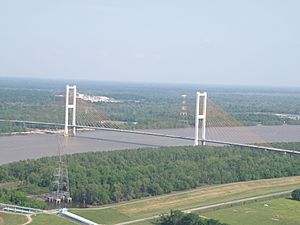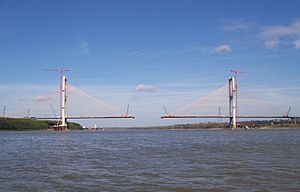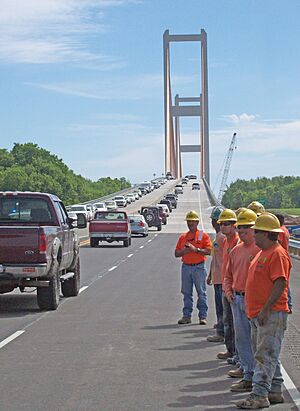John James Audubon Bridge (Mississippi River) facts for kids
Quick facts for kids John James Audubon Bridge |
|
|---|---|
 |
|
| Coordinates | 30°43′13.32″N 91°21′5.36″W / 30.7203667°N 91.3514889°W |
| Carries | 4 lanes of |
| Crosses | Mississippi River |
| Locale | Pointe Coupee Parish, Louisiana, West Feliciana Parish, Louisiana |
| Maintained by | LaDOTD |
| Characteristics | |
| Design | Cable-stayed bridge |
| Total length | 12,883 ft (3,927 m) |
| Width | 75.8 ft (23.1 m) |
| Height | 520 ft (158 m) |
| Longest span | 1,583 ft (482 m) |
| Clearance below | 65 ft (20 m) minimum at HWL (High Water Level); the MHWL (Mean High Water Level) clearance is 76.2 ft (23.2 m); the LWL (Low Water Level) clearance is 116.1 ft (35.4 m) |
| History | |
| Construction cost | $409 million |
| Opened | May 5, 2011 |
| Replaces | New Roads–St. Francisville Ferry |
The John James Audubon Bridge is a very long bridge that crosses the Mississippi River in south central Louisiana. It opened in 2011. This bridge connects Pointe Coupee and West Feliciana parishes.
It has one of the longest main spans (the distance between its tall towers) of any cable-stayed bridge in the Western Hemisphere. Its main span is 1,583 ft (482 m) long. The entire bridge stretches for 12,883 ft (3,927 m).
The Audubon Bridge took the place of an old ferry boat. This ferry used to carry people and cars between the towns of New Roads and St. Francisville. The bridge is also the only one over the Mississippi River for about 90 miles. This stretch is between Natchez, Mississippi and Baton Rouge, Louisiana. The bridge carries Louisiana Highway 10.
Contents
Building the Bridge
The Audubon Bridge project included several big parts:
- A long, elevated bridge structure with four lanes for cars. It has two lanes going each way.
- About 12 miles (19 km) of new two-lane roads. These roads connect existing highways.
- Four new intersections to help cars get on and off the new road and bridge.
The bridge was officially connected across the Mississippi River on December 29, 2010. It was supposed to open in June 2011. However, it opened earlier on May 5, 2011. This was because the Mississippi River's water levels were rising. The high water had forced the ferry service to close.
The bridge has special sliding joints. These joints allow the bridge decks to move a lot. This helps the bridge handle changes in temperature and other forces. These large joints were designed by mageba, an engineering company.
Audubon Bridge Constructors built the bridge. This was a team-up of several companies. The Louisiana Department of Transportation and Development now owns the bridge. The bridge helps people travel much faster. Before, they had to use ferries or take long detours.
Why the Name "Audubon"?
The bridge is named after John James Audubon. He was a famous artist who painted all the birds in North America. In 1821, he painted 32 of his well-known "Birds of America" works. He did this while living at Oakley Plantation in St. Francisville. He was working there as a tutor.
Naming the bridge after Audubon shows how important the area's rich natural history is. It also highlights efforts to protect it.
Renaming Discussions
In 2011, some people wanted to change the bridge's name. They suggested calling it the "Generals John A. Lejeune-Robert H. Barrow Bridge." They argued that Audubon didn't spend much time in Louisiana. Also, there were already other bridges named after him.
They said that Generals John A. Lejeune and Robert H. Barrow deserved the honor more. Both generals were from the parishes the bridge connects. They both served as leaders of the United States Marine Corps.
A compromise was reached. The bridge still keeps Audubon's name. However, the east road leading to the bridge is now called the "General Robert H. Barrow Memorial Approach." The west road is named the "General John A. Lejeune Memorial Approach."
Awards for the Bridge
In 2013, a magazine called Engineering News-Record gave the bridge two awards. It won for being the best transportation project. It also received the "Editor's Choice" award. This meant it was chosen as "the top construction project recently completed in the United States."
Concerns About the Bridge
The bridge project faced some concerns:
- Cost and Time: In 1992, the bridge was expected to cost $50 million and be finished by 1998. It actually cost $409 million and opened in 2011.
- Traffic: It was predicted to carry 4,000 vehicles each day. In its first year, it carried about 2,887 vehicles daily. This was still much more than the 720 vehicles the old ferry carried. Experts think traffic will increase to 9,600 vehicles per day by 2026.
- Location: The mayor of St. Francisville did not want the bridge near the old ferry. This was because it would block views of historic homes and cemeteries. The chosen location was further south. Some people worried this spot was too close to a nuclear power plant. If there were an emergency at the plant, the bridge might not be useful for people trying to leave the area. Some also believe the bridge's location has not helped local businesses as much as expected. This is because a larger city, Zachary, is nearby and offers more shopping options.
See also
 In Spanish: Puente John James Audubon para niños
In Spanish: Puente John James Audubon para niños



